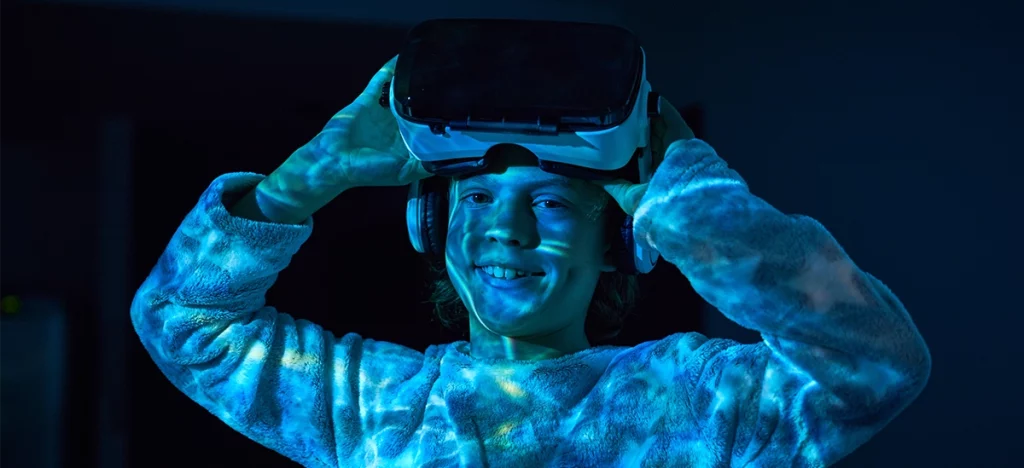At this point, it’s likely most of us have heard of the buzz-word ‘metaverse’ to some extent. Indeed, as personalities offer their own definitions and takes on the matter, simply put, it’s a form of virtual reality. Accordingly, what is virtual reality, how does VR work and where does it stand? Read on as we ponder such questions below!
Virtual Reality – How Does it Work?
So, let’s start with the textbook definition of virtual reality:
Virtual reality is the computer-generated simulation of a three-dimensional image or environment that can be interacted with in a seemingly real or physical way by a person using special electronic equipment, such as a helmet with a screen inside or gloves fitted with sensors.
Credits: Oxford Languages
Simply put, virtual reality, or VR is a 3D environment generated by computing software which may be interacted with, but isn’t real. However, do note that ‘being interactive’ is not necessarily an essential component of the definition, though it’s arguably the main differing term from something like ‘3D movies’.
With regards to virtual reality, VR technology has matured over the past 60 years, with 1968 being pinned as the date for its modern-day birth. Back then, the technology consisted of a heavy, bulky headset was rather awkward, but the proof of concept was there.
Offering some great writing material for science fiction, nobody thought the technology would reach the capacities of modern VR. Set to be worth $184,66 billion by 2026, VR is a fast-growing technology!
Virtual Reality Technology – Science and Gaming
As the millenium turned, two main potentials are seen for Virtual Reality – namely science and gaming. So while NASA would invest in VR, so would SEGA and Nintendo.
From the aspect of science, VR would offer a new avenue for the treatment of PTSD (post-traumatic stress disorder) and a means to pilot a simulated rover-vehicle on the surface of Mars.
For gaming, SEGA devised one or two prototypes, Nintendo built the Virtual Boy and by 2012, Oculus would start a kickstarter.
Now, before skipping to modern day, let’s first develop an idea of how virtual reality works.

The Basics of VR – A Brief Summary
Firstly, we’ll preface by saying that not all VR technologies are the same, and manufacturers are always innovating. How does a VR headset transport oneself into another version of reality?
- VR Headset – with gyroscopic sensors, accelerators and magnetometers – designed to track and determine your movements to sync with the computer generated reality
- VR controllers – usually one in each hand, allows users to interact with the world and position their hands appropriately
- External cameras – apart from tracking your head, allows tracking of limbs and controllers
- PC (personal computer) – often needing a moderate to high end system, the PC puts all the information together and generates the experience
Each component has evolved with time, and differ slightly with each consumer product available.
Modern Horizon of VR Consumer Products
Picking up where we left off, Oculus started funding its kickstarter back in 2012.
Considering an impressive backing, the larger stakeholders in related industries start to smell the potential. Specifically, Facebook buys out Oculus while Sony kickstarts its own VR project. Notably, a VR system on a console, often recognized as weaker than a PC, turned many heads.
In addition, Google Cardboard and Samsung VR also get on board at this point in time.
And then came 2016 – the official release of the Oculus Rift is accompanied by competition from the HTC Vive.
Since then, yearly upgrades for the top products have been available, evolving in certain parameters.
Virtual Reality – Crunching the Numbers
With each product, it’s clear that everyone is trying to improve some common variables which heavily influence the VR experience:
- Field of View
- Frame Rate
- Spatial Audio and Sound Effects
- Position and Head Tracking
- Comfort
- Ease of Use
In my opinion, that last point is of particular importance. Considering the number of inputs involved for VR and the notion of wearing a headset and headphones, it may be viewed as an experienced hindered by wires and discomfort.
As sleeker designs hit the market, and less powerful PCs are required, the technology is now more accessible to the general community then ever.
60 years ago, VR was born with the aim of making science and gaming more immersive – 60 years later, the technology has simply expanded to multiple industries, limited only by imagination.
The Future of Virtual Reality – The Metaverse?
And now, we’re back to where we started.
The future of virtual reality, while it may involve incremental technological improvements, mainly relies on its implementation and the creativity if publishers. When it comes to something like the ‘metaverse’, VR is an essential tool which will likely shape other technologies in the near future.
For more news on technology, esports and gaming, visit our news site here: https://playcon.gg/news/